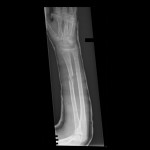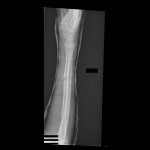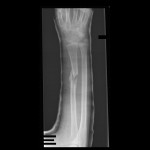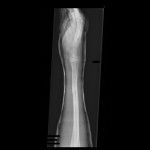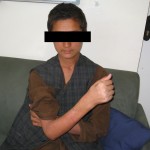With minimal shortening and the ability to regain radial bow with a molded cast, the surgeon decided to treat Farhad M. with a long-arm cast with an intraosseous mold.
His above-elbow cast was removed 6 weeks later. The extensor carpi radialis longus repair was functioning and he was not tender at the fracture. At this point, Farhad M. began range of motion exercises and protected the arm. Pronation and supination were 40 degrees each.
Additional Reading
J Surg Orthop Adv. 2010 Spring;19(1):49-53.
Outcomes of Internal Fixation in a Combat Environment.
Stinner DJ, Keeney JA, Hsu JR, Rush JK, Cho MS, Wenke JC, Ficke JR.
Department of Regenerative Medicine, United States Army Institute of Surgical Research, 3400 Rawley E. Chambers Avenue, San Antonio, TX 78234, USA. daniel (dot) stinner (at) amedd.army.mil
Abstract
Due to the nature of the wounds and environment, internal fixation in battlefield treatment facilities is discouraged despite the lack of data. The purpose of this review is to describe the outcomes of fractures that were internally fixed in the combat environment. The records of patients who had internal fixation performed in the theater of combat operations were reviewed. Demographics, injury characteristics, procedure history, and outcomes were recorded and analyzed. Forty-seven patients had internal fixation performed on 50 fractures in a combat theater hospital. Hip, forearm, and ankle fractures made up the majority of cases with 14 (28%), 14 (28%), and 10 (20%), respectively. Sixteen (32%) fractures were open. The average Injury Severity Score was 11.4 +/- 1.1 (range, 4-34). Thirty-nine fractures (78%) healed without incidence. There was one (2%) infection and one (2%) acute surgical complication. Ten (20%) fractures, including the one infection, required additional procedures. Because internal fixation in the combat environment was used judiciously, complications were not higher than previously reported.


